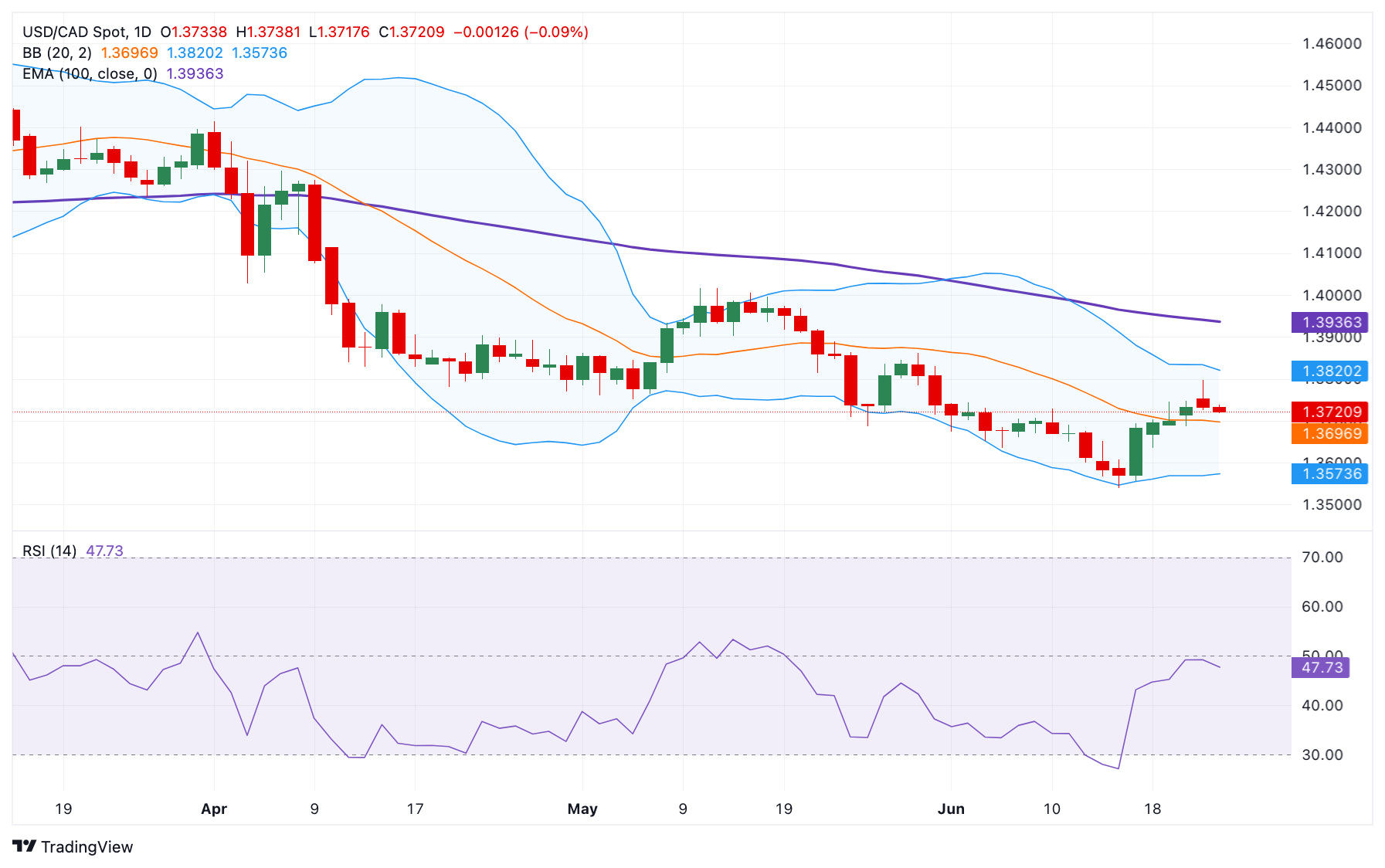USD/CAD Price Forecast: Bearish outlook remains in play below 1.3750
- USD/CAD edges lower to around 1.3720 in Tuesday’s early European session.
- The pair keeps the negative outlook below the 100-day EMA with a bearish RSI indicator.
- The initial support emerges at 1.3635; the first upside barrier is located at 1.3820.
The USD/CAD pair trades in negative territory around 1.3720 during the early European session on Tuesday. The Greenback weakens against the Canadian Dollar (CAD) as a ceasefire between Iran and Israel comes into effect following four waves of Iranian attacks on Israeli-occupied territories.
Furthermore, the dovish comments from the US Federal Reserve (Fed) policymakers also undermine the US Dollar (USD). Fed Governor Michelle Bowman said Monday she would favor an interest rate reduction at the next policy meeting in July so long as inflation pressures stay muted.
According to the daily chart, the bearish outlook of USD/CAD remains in play as the pair remains capped below the key 100-day Exponential Moving Average (EMA). The path of least resistance is to the downside, with the 14-day Relative Strength Index standing below the midline near 47.75.
The first downside target for the pair emerges at 1.3635, the low of June 18. Extended losses could see a drop to 1.3575, the lower limit of the Bollinger Band. The next contention level for USD/CAD is seen at 1.3540, the low of June 16.
On the bright side, the immediate resistance level is located at 1.3820, the upper boundary of the Bollinger Band. Sustained trading above this level could attract some buyers to 1.3862, the high of May 29. Further north, the next hurdle to watch is 1.3935, the 100-day EMA.
USD/CAD Daily Chart

Canadian Dollar FAQs
The key factors driving the Canadian Dollar (CAD) are the level of interest rates set by the Bank of Canada (BoC), the price of Oil, Canada’s largest export, the health of its economy, inflation and the Trade Balance, which is the difference between the value of Canada’s exports versus its imports. Other factors include market sentiment – whether investors are taking on more risky assets (risk-on) or seeking safe-havens (risk-off) – with risk-on being CAD-positive. As its largest trading partner, the health of the US economy is also a key factor influencing the Canadian Dollar.
The Bank of Canada (BoC) has a significant influence on the Canadian Dollar by setting the level of interest rates that banks can lend to one another. This influences the level of interest rates for everyone. The main goal of the BoC is to maintain inflation at 1-3% by adjusting interest rates up or down. Relatively higher interest rates tend to be positive for the CAD. The Bank of Canada can also use quantitative easing and tightening to influence credit conditions, with the former CAD-negative and the latter CAD-positive.
The price of Oil is a key factor impacting the value of the Canadian Dollar. Petroleum is Canada’s biggest export, so Oil price tends to have an immediate impact on the CAD value. Generally, if Oil price rises CAD also goes up, as aggregate demand for the currency increases. The opposite is the case if the price of Oil falls. Higher Oil prices also tend to result in a greater likelihood of a positive Trade Balance, which is also supportive of the CAD.
While inflation had always traditionally been thought of as a negative factor for a currency since it lowers the value of money, the opposite has actually been the case in modern times with the relaxation of cross-border capital controls. Higher inflation tends to lead central banks to put up interest rates which attracts more capital inflows from global investors seeking a lucrative place to keep their money. This increases demand for the local currency, which in Canada’s case is the Canadian Dollar.
Macroeconomic data releases gauge the health of the economy and can have an impact on the Canadian Dollar. Indicators such as GDP, Manufacturing and Services PMIs, employment, and consumer sentiment surveys can all influence the direction of the CAD. A strong economy is good for the Canadian Dollar. Not only does it attract more foreign investment but it may encourage the Bank of Canada to put up interest rates, leading to a stronger currency. If economic data is weak, however, the CAD is likely to fall.

